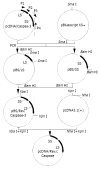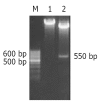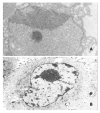Apoptosis-inducing effect of recombinant Caspase-3 expressed by constructed eukaryotic vector on gastric cancer cell line SGC7901
- PMID: 12970879
- PMCID: PMC4656647
- DOI: 10.3748/wjg.v9.i9.1935
Apoptosis-inducing effect of recombinant Caspase-3 expressed by constructed eukaryotic vector on gastric cancer cell line SGC7901
Abstract
Aim: To investigate the apoptosis-inducing effect of Caspases-3 expressed by constructed eukaryotic vector on gastric cancer cell line SGC7901.
Methods: PCR was employed to amplify the sequences of both small and large subunits of Caspases-3. Its products were separately cloned into the Sma I site of pBluescript KS(+) to generate both plasmids pBS/SS and pBS/LS. The small subunit fragment was excised from plasmid pBS/SS with BamH I and then inserted into the BamH I site of plasmid pBS/LS preceding that of the large subunit to yield plasmid pBS/Rev-Caspase-3. Rev-Caspase-3 cDNA was excised with Kpn I+Xba I and then subcloned into plasmid pcDNA3.1 (+) to construct Rev-Caspase-3 eukaryotic expression vector pcDNA/Rev-Caspase-3, which was used to transiently transfect SGC7901 cell line. Cell count, MTT assay and electron microscopy were used to confirm the antiproliferation and apoptosis-inducing effect of Rev-Caspase-3 expression on gastric cancer cells.
Results: Plasmid pBS/Rev-Caspase-3 and eukaryotic expression vector pcDNA/Rev-Caspase-3 were successfully constructed. SGC7901 cells were transiently transfected by either pcDNA/Rev-Caspase-3 or pcDNA3.1 (+) for 24, 48, 72, and 96 h respectively. Cell growth was measured by cell count and MTT assay. In cell count assay, the cell numbers were 1.8 X 10(6), 1.55 X 10(6), 2.0 X 10(6), and 3.1 X 10(6) in the experimental group and 2.5 X 10(6), 3.1 X 10(6), 4.0 X 10(6), and 5.7 X 10(6) in the control group at 24, 48, 72 and 96 h respectively. The growth of SGC7901 cells was suppressed by Rev-Caspase-3 in a time-dependent manner (P<0.05). The results of MTT assay were similar to that of cell count (P<0.05). The characteristics of apoptosis such as chromatin condensation, crescent formation and margination were seen and more obvious with time in the given-experimental period in the experimental group, but not easily observed in the control group.
Conclusion: The expression of Rev-Caspase-3 by the constructed eukaryotic vector can significantly induce apoptosis of gastric cancer cell line SGC7901, which may exhibit a potential way in gastric cancer gene therapy.
Figures






References
-
- Sauer G, Deissler H, Kurzeder C, Kreienberg R. New molecular targets of breast cancer therapy. Strahlenther Onkol. 2002;178:123–133. - PubMed
-
- Castiglioni P, Martin-Fontecha A, Milan G, Tomajer V, Magni F, Michaelsson J, Rugarli C, Rosato A, Bellone M. Apoptosis-dependent subversion of the T-lymphocyte epitope hierarchy in lymphoma cells. Cancer Res. 2002;62:1116–1122. - PubMed
-
- Paczesny S, Beranger S, Salzmann JL, Klatzmann D, Colombo BM. Protection of mice against leukemia after vaccination with bone marrow-derived dendritic cells loaded with apoptotic leukemia cells. Cancer Res. 2001;61:2386–2389. - PubMed
-
- Amin S, Robins RA, Maxwell-Armstrong CA, Scholefield JH, Durrant LG. Vaccine-induced apoptosis: a novel clinical trial end point. Cancer Res. 2000;60:3132–3136. - PubMed
MeSH terms
Substances
LinkOut - more resources
Full Text Sources
Other Literature Sources
Medical
Research Materials

